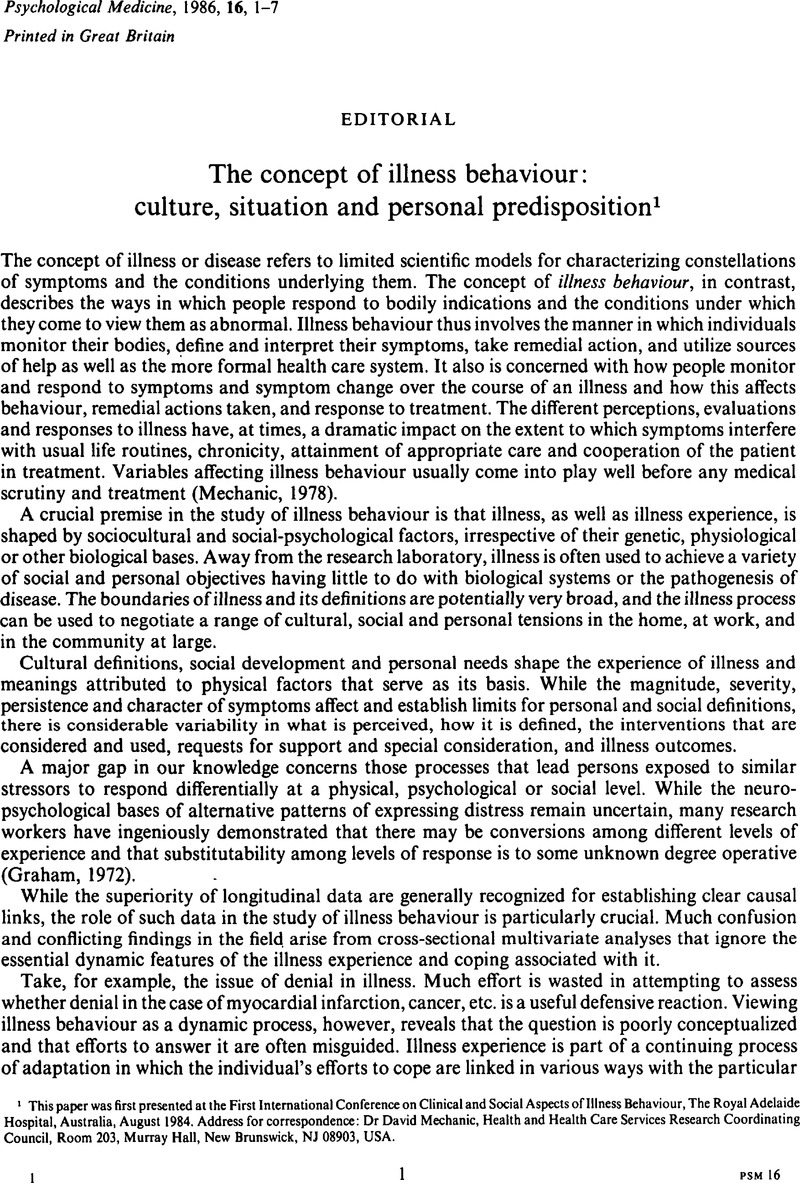Crossref Citations
This article has been cited by the following publications. This list is generated based on data provided by Crossref.
Mechanic, D.
1986.
Some Relationships Between Psychiatry and the Social Sciences.
British Journal of Psychiatry,
Vol. 149,
Issue. 5,
p.
548.
Pietroni, Patrick C
and
Aldridge, David
1987.
Summary of Discussion on BMA Report.
Holistic Medicine,
Vol. 2,
Issue. 2,
p.
95.
Schlebusch, L.
1987.
Medical Psychology in Southern Africa: Future Concerns in the General Teaching Hospital.
South African Journal of Psychology,
Vol. 17,
Issue. 3,
p.
110.
Power, M. J.
1987.
Theoretical Foundations of Behavior Therapy.
p.
235.
Grassi, Luigi
Rosti, G.
Albieri, G.
and
Marangolo, M.
1989.
Depression and abnormal illness behavior in cancer patients.
General Hospital Psychiatry,
Vol. 11,
Issue. 6,
p.
404.
Mayou, Richard
1989.
Illness behavior and psychiatry.
General Hospital Psychiatry,
Vol. 11,
Issue. 5,
p.
307.
Hoeman, Shirley P.
1989.
Cultural Assessment in Rehabilitation.
Nursing Clinics of North America,
Vol. 24,
Issue. 1,
p.
277.
Waddell, Gordon
Pilowsky, Issy
and
Bond, Michael R.
1989.
Clinical assessment and interpretation of abnormal illness behaviour in low back pain.
Pain,
Vol. 39,
Issue. 1,
p.
41.
Tyrer, Stephen P.
Capon, Mark
Peterson, David M.
Charlton, Edmond J.
and
Thompson, John W.
1989.
The detection of psychiatric illness and psychological handicaps in a British pain clinic population.
Pain,
Vol. 36,
Issue. 1,
p.
63.
Willmott, Martin
1989.
Health Psychology.
p.
57.
McGorry, Patrick D.
Copolov, David L.
and
Singh, Bruce S.
1990.
Current concepts in functional psychosis.
Schizophrenia Research,
Vol. 3,
Issue. 4,
p.
221.
Ballinger, C. B.
1990.
Psychiatric Aspects of the Menopause.
British Journal of Psychiatry,
Vol. 156,
Issue. 6,
p.
773.
1990.
Managing somatization disorder.
Disease-a-Month,
Vol. 36,
Issue. 10,
p.
542.
Thorne, Sally E.
1990.
Mothers with chronic illness: A predicament of social construction.
Health Care for Women International,
Vol. 11,
Issue. 2,
p.
209.
Marshall, Patricia A.
1990.
Cultural influences on perceived quality of life.
Seminars in Oncology Nursing,
Vol. 6,
Issue. 4,
p.
278.
Waddell, Gordon
1991.
Low Back Disability.
Neurosurgery Clinics of North America,
Vol. 2,
Issue. 4,
p.
719.
Watson, David
and
Pennebaker, James W.
1991.
Mental Representation in Health and Illness.
p.
60.
Krefting, Laura
1991.
The Culture Concept in the Everyday Practice of Occupational and Physical Therapy.
Physical & Occupational Therapy In Pediatrics,
Vol. 11,
Issue. 4,
p.
1.
Stoudemire, Alan
1991.
Somatothymia.
Psychosomatics,
Vol. 32,
Issue. 4,
p.
365.
Shorter, Edward
Abbey, Susan E.
Gillies, Laurie A.
Singh, Malini
and
Lipowski, Zbigniew J.
1992.
Inpatient Treatment of Persistent Somatization.
Psychosomatics,
Vol. 33,
Issue. 3,
p.
295.





